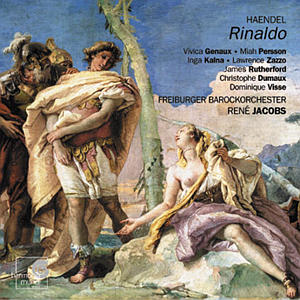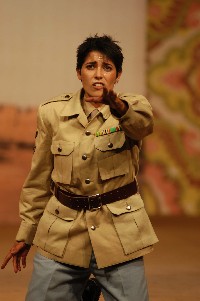This recording of Handel’s first Italian opera composed for London is, as
is often the case with René Jacobs’s records, definitely something special,
indeed strange. As with Hogwood’s recent recording, this contains the original
1711 version, although Jacobs has made several very personal choices. Most of
these are explained in his booklet essay. Some of Jacobs’s decisions were made
due to the absence of staging when you listen to a record, and therefore he
decided to compensate for this lack of visual stimulation. Thus Jacobs
attempts to illustrate some stage directions, for example by adding
instrumental preludes to two scenes, or using strange sound effects: the weird
noises during the recitative preceding Armida’s aria “Vo far guerra” sound
like something from Pierre Henry experimental music or from the soundtrack of
the first Star Trek series, and are supposed to illustrate heavy … silences
(!). What can be said of the squalling intervention of the mermaid at the end
of “Il tricerbero umiliato” or the use of castanets in “Il vostro maggio” (Act
II scene 3)? In Nigel Lowery’s staged production these fitted the visual
action quite well, but even then it resembled a bad fairground show, and their
resurgence here is useless.
Jacobs’s intentions sometimes appear praiseworthy, but his justification
that they compensate for the lack of a visual dimension is hardly convincing
as almost all those adaptations were already used during the fully staged
performances that were also conducted by Jacobs. This lack of trust in the
recording’s audience is quite surprising, not least because anyone is able to
read the stage directions written in the libretto. Often the historical
relevance of Jacobs’s choices is quite erratic. However, the use of music by
William Babell is one of Jacobs’s most interesting decisions. Considering the
harpsichordist played in Handel’s orchestra (but he played several
instruments) and wrote keyboard adaptations of several arias from Rinaldo,
Jacobs decided to make several changes inspired by Babell’s arrangements. The
use of Babell’s music as a source of inspiration for ornaments and variations
or even for the harpsichord candenzas in Armida’s “Vo far guerra” (Act II
scene 10) is one of the more relevant elements of Jacobs’s approach. Far worse
is the addition of a continuo part in arias that Handel specifically indicated
should be played “senza bassi” (e.g. Goffredo’s “No, no, quest’alma”,
Act I scene 3; Almirena’s “Bel piacere”, Act III scene 7). This is complete
nonsense, and even though a rich continuo definitely enables efficient
effects, the parsimonious use of an organ is totally unhistorical here.
Fortunately, a recording is not to be considered only from historical and
musicological perspectives. After the listener is warned that this allegedly
historically informed recording could actually make him a historically
disinformed listener, the performance will give him many pleasures. To sing
Almirena after Cecilia Bartoli could have seemed a terrible challenge for any
singer, but Miah Persson’s performance is excellent and much denser than it
was on stage, and she also demonstrates that this part better fits her voice
than Bartoli’s. Vivica Genaux’s case is quite different: her embodiment is
much more convincing too than it was on stage, and her voice fits certainly
the role more comfortably than it did David Daniels’s. But Genaux definitely
lacks the emotional intensity which is such an impressive part of the American
countertenor’s voice. Despite Genaux’s tone being too nasal, and her need to take too
many breaths, her singing is often excellent and her involvement is
undeniable. Yet her performance is fundamentally admirable rather than
particularly moving, even if her “Cara sposa” (Act I scene 7) is fine. Inga
Kalna does take risks, and sometimes hovers close to the razor’s edge, but she
is ultimately an ideal Armida, singing with beautiful colours in her voice
that are too rarely heard in this role. The secondary parts are well served,
particularly Christophe Dumaux’s Eustazio.
It is worth noting that this recording features very interesting da capos;
even if they are not always especially spectacular, they tend to be really
exciting and stylish. On one hand, Jacobs’s preference to adopt steady speeds
for Handel’s fast tempo markings enables such da capos, but with the
disadvantage that several allegro arias are too close too andante or even
larghetto. Thus Argante seems particularly resigned in “Vieni o cara” (Act I
scene 4), the sirens sound very restrained (“Il vostro maggio”, Act II scene
3). Rinaldo’s finale aria “Or la tromba” (Act III scene 9) is not devoid of
solemnity but dramatically flat, and Rinaldo doesn’t seem at all in a hurry to
join the battle. However, whatever the tempos are, the sumptuous Freiburger
Barockorchester contributes prominently to the theatricality and efficiency of
the performance. Many more aspects of this recording could (or should) be
discussed, but the whole performance is mostly enjoyable: this is a brilliant,
well-balanced, beautiful, and highly debatable recording of Handel’s
Rinaldo as reinterpreted by René Jacobs.




